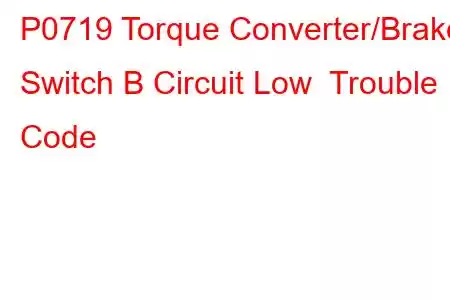P0719 Torque Converter/Brake Switch B Circuit Low
OBD-II Trouble Code Technical Description
Torque Converter/Brake Switch B Circuit Low
What does that mean?
This diagnostic trouble code (DTC) is a generic powertrain code, which means that it applies to all 1996-newer vehicles (Ford, Honda, Mazda, Mercedes, VW, etc.). Although generic, the specific repair steps may vary depending on make/model.
If you discover that a code P0719 has been stored in your OBD-II vehicle, it means that the powertrain control module (PCM) has detected a low voltage situation in a certain torque converter brake switch circuit. This code is applicable to vehicles equipped with automatic transmissions only.
Automatic transmissions (in mass produced vehicles) have been electronically controlled since the 1980s. Most OBD-II equipped vehicles are managed by a transmission controller that is integrated into the PCM. Other vehicles utilize a stand-alone transmission control module that communicates with the PCM and other controllers via the controller area network (CAN).
The torque converter is a type of fluid coupling that links the engine to the transmission. When the vehicle is in motion, the torque converter allows torque to be transferred to the transmission input shaft. When the vehicle comes to a stop (with the engine idling) the torque converter absorbs the torque of the engine, using a complex system of wet clutches. This allows the engine to idle without stalling.
The lockup torque converter, used in OBD-II equipped vehicles, allows the engine to lock into the transmission input shaft under certain conditions. This usually occurs when the transmission has shifted into the highest gear, the vehicle has reached a certain speed, and the desired engine RPM level has been achieved. In lockup mode, the torque converter clutch (TCC) is restricted gradually until the transmission is functioning as though it were bolted directly to the engine in a 1:1 transfer ratio. These gradual clutch restrictions are known as percentage of torque converter lockup. This system promotes fuel efficiency and optimal engine performance. Torque converter lockup is achieved using an electronic solenoid that controls a spring loaded rod or ball valve. When the PCM recognizes that conditions are correct, the lockup solenoid is activated and the valve allows fluid to bypass the torque converter (gradually) and be applied directly to the valve body.
Torque converter lockup must be disengaged before engine RPM levels decrease to a certain level and definitely before the vehicle comes to a stop, with the engine idling. If not, the engine will undoubtedly stall. One of the specific signals that the PCM looks for in torque converter lockup disengagement is the application of the brake pedal. When the brake pedal is applied, the brake lever arm causes contacts in the brake switch to be closed, completing one or more circuit/s. When these circuits are completed, the stop lamps are illuminated. A second signal is sent to the PCM. This signal lets the PCM know that the brake pedal has been depressed and the torque converter lockup solenoid needs to be disengaged.
The P0719 code pertains to one of these brake switch circuits. Consult your vehicle service manual or service site such as AllDataDIY for specific information about this particular circuit as it relates to your vehicle.
Symptoms & Severity
This code should be treated as urgent because severe internal transmission damage could result if the TCC lockup is inoperable over a long period of time. Most models are designed so that the PCM will disable TCC lockup, and place the transmission control system in limp-in mode, if a code of this type is stored.
Symptoms of a P0719 code may include:
Engine stalling when the vehicle rolls to a stop TCC lockup may be disabled Diminished fuel efficiency DecreaseRead: 28


